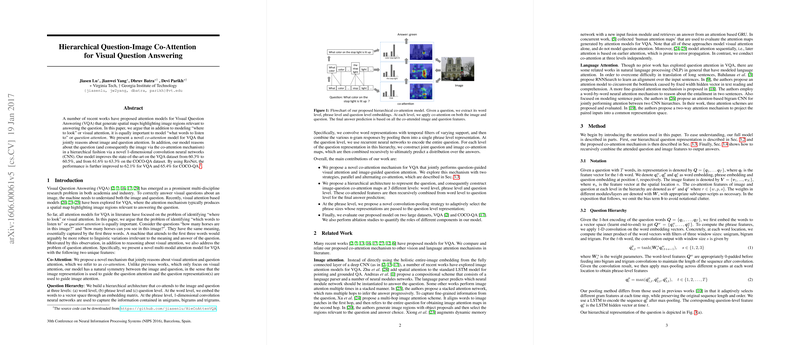Hierarchical Question-Image Co-Attention for Visual Question Answering
The paper "Hierarchical Question-Image Co-Attention for Visual Question Answering" by Jiasen Lu, Jianwei Yang, Dhruv Batra, and Devi Parikh introduces a novel approach to addressing the Visual Question Answering (VQA) problem. VQA is a multi-disciplinary problem that requires a model to provide accurate answers to questions based on the content of an image. The core contribution of this paper is the development of a co-attention model that simultaneously focuses on both pertinent regions in the image and relevant words in the question, hence enhancing the interpretive capacity of the VQA system.
Contributions
The main contributions of this paper include:
- Co-Attention Mechanism: A co-attention mechanism was developed to jointly generate image and question attention maps. This mechanism diverges from previous models that primarily concentrated on visual attention, integrating question attention to provide a more holistic interpretational framework.
- Hierarchical Representation of Questions: The authors proposed a hierarchical architecture that represents the question at three different levels: word, phrase, and question level. These hierarchical features are conjointly used to generate co-attention maps.
- Novel Convolution-Pooling Strategy: At the phrase level, the paper introduces a convolution-pooling strategy that dynamically selects phrase sizes for representation, optimizing the model's adaptability to varying linguistic structures.
- Benchmark Performance: The model was evaluated on two substantial datasets, VQA and COCO-QA, revealing improvements in state-of-the-art results from 60.3% to 62.1% on VQA and from 61.6% to 65.4% on COCO-QA.
Methodology
Hierarchical Question Representation
The paper proposes a hierarchical question encoding mechanism. The question is processed at three levels:
- Word Level: Individual words are embedded into a vector space.
- Phrase Level: A 1-dimensional convolution (with unigrams, bigrams, and trigrams) followed by max-pooling is used to capture phrase-level features.
- Question Level: The phrase-level embeddings are encoded using an LSTM to derive the question-level embedding.
Co-Attention Mechanism
Two co-attention strategies were proposed:
- Parallel Co-Attention: This technique produces attention maps for the image and question simultaneously by computing an affinity matrix representing similarity scores between the image and question features.
- Alternating Co-Attention: This method alternates between question attention and image attention. Initially, a question summarization is performed, followed by image attention and a subsequent re-attention on the question based on the updated image features.
Both strategies aggregate attention hierarchically across the word, phrase, and question levels, enhancing the model's capability to understand and connect visual and textual data progressively.
Numerical Results and Analysis
Improvements in Benchmark Performance
The model demonstrated superior performance on the VQA and COCO-QA datasets. Specific improvements noted include:
- On the VQA dataset, the performance improved from 60.3% to 62.1% for open-ended questions and from 64.2% to 66.1% for multiple-choice questions.
- On the COCO-QA dataset, results saw a leap from 61.6% to 65.4%, which illustrates the efficacy of the hierarchical co-attention strategy.
Ablation Studies
The authors conducted thorough ablation studies to demonstrate the contributions of various components of their model. It was found that the highest performance contributions came from the question-level attention, followed by phrase-level and word-level attentions.
Implications and Future Directions
The incorporation of co-attention strategies that process both visual and textual information simultaneously or in an alternated manner opens new avenues for developing more robust multi-modal AI systems. This dual-attention perspective is critical for improving model robustness to linguistic variations and complex visual stimuli.
Furthermore, the hierarchical processing of the question ensures that varying granularities of textual information are captured, thus enhancing the overall comprehension of the question by the model.
Conclusion
This paper offers significant contributions to the VQA field by introducing a dual-attentive hierarchical model. Through both theoretical advancements and practical performance improvements, it lays the groundwork for future research in multi-modal deep learning models. As AI continues to evolve, such intricate models that efficiently integrate and process visual and textual data will be indispensable for various applications, including but not limited to automated captioning, interactive AI, and real-time image-based querying systems.
